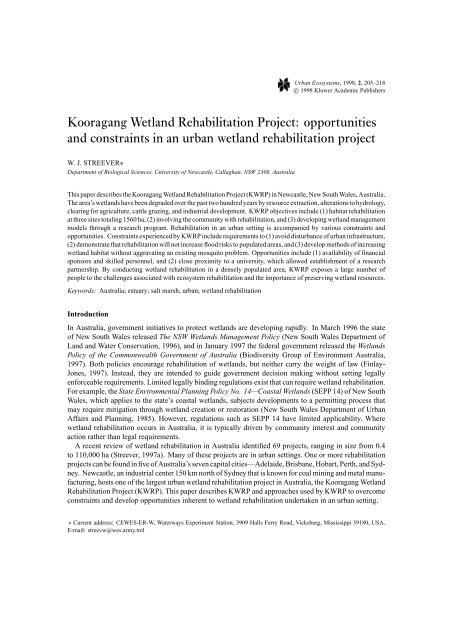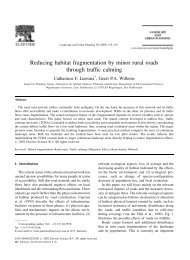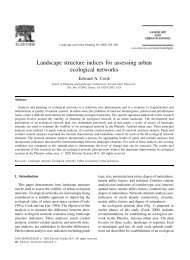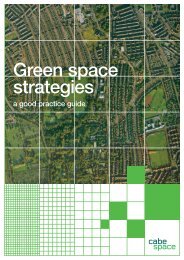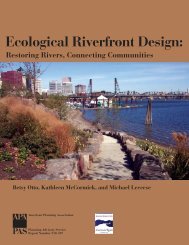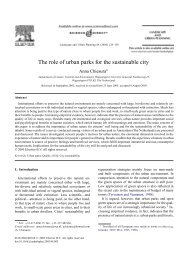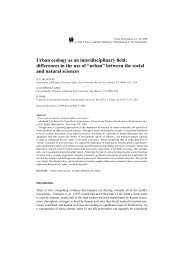Kooragang Wetland Rehabilitation Project - Carmelacanzonieri.com
Kooragang Wetland Rehabilitation Project - Carmelacanzonieri.com
Kooragang Wetland Rehabilitation Project - Carmelacanzonieri.com
You also want an ePaper? Increase the reach of your titles
YUMPU automatically turns print PDFs into web optimized ePapers that Google loves.
Urban Ecosystems, 1998, 2, 205–218<br />
c○ 1998 Kluwer Academic Publishers<br />
<strong>Kooragang</strong> <strong>Wetland</strong> <strong>Rehabilitation</strong> <strong>Project</strong>: opportunities<br />
and constraints in an urban wetland rehabilitation project<br />
W. J. STREEVER∗<br />
Department of Biological Sciences, University of Newcastle, Callaghan, NSW 2308, Australia<br />
This paper describes the <strong>Kooragang</strong> <strong>Wetland</strong> <strong>Rehabilitation</strong> <strong>Project</strong> (KWRP) in Newcastle, New South Wales, Australia.<br />
The area’s wetlands have been degraded over the past two hundred years by resource extraction, alterations to hydrology,<br />
clearing for agriculture, cattle grazing, and industrial development. KWRP objectives include (1) habitat rehabilitation<br />
at three sites totaling 1560 ha, (2) involving the <strong>com</strong>munity with rehabilitation, and (3) developing wetland management<br />
models through a research program. <strong>Rehabilitation</strong> in an urban setting is ac<strong>com</strong>panied by various constraints and<br />
opportunities. Constraints experienced by KWRP include requirements to (1) avoid disturbance of urban infrastructure,<br />
(2) demonstrate that rehabilitation will not increase flood risks to populated areas, and (3) develop methods of increasing<br />
wetland habitat without aggravating an existing mosquito problem. Opportunities include (1) availability of financial<br />
sponsors and skilled personnel, and (2) close proximity to a university, which allowed establishment of a research<br />
partnership. By conducting wetland rehabilitation in a densely populated area, KWRP exposes a large number of<br />
people to the challenges associated with ecosystem rehabilitation and the importance of preserving wetland resources.<br />
Keywords: Australia; estuary; salt marsh; urban; wetland rehabilitation<br />
Introduction<br />
In Australia, government initiatives to protect wetlands are developing rapidly. In March 1996 the state<br />
of New South Wales released The NSW <strong>Wetland</strong>s Management Policy (New South Wales Department of<br />
Land and Water Conservation, 1996), and in January 1997 the federal government released the <strong>Wetland</strong>s<br />
Policy of the Commonwealth Government of Australia (Biodiversity Group of Environment Australia,<br />
1997). Both policies encourage rehabilitation of wetlands, but neither carry the weight of law (Finlay-<br />
Jones, 1997). Instead, they are intended to guide government decision making without setting legally<br />
enforceable requirements. Limited legally binding regulations exist that can require wetland rehabilitation.<br />
For example, the State Environmental Planning Policy No. 14—Coastal <strong>Wetland</strong>s (SEPP 14) of New South<br />
Wales, which applies to the state’s coastal wetlands, subjects developments to a permitting process that<br />
may require mitigation through wetland creation or restoration (New South Wales Department of Urban<br />
Affairs and Planning, 1985). However, regulations such as SEPP 14 have limited applicability. Where<br />
wetland rehabilitation occurs in Australia, it is typically driven by <strong>com</strong>munity interest and <strong>com</strong>munity<br />
action rather than legal requirements.<br />
A recent review of wetland rehabilitation in Australia identified 69 projects, ranging in size from 0.4<br />
to 110,000 ha (Streever, 1997a). Many of these projects are in urban settings. One or more rehabilitation<br />
projects can be found in five of Australia’s seven capital cities—Adelaide, Brisbane, Hobart, Perth, and Sydney.<br />
Newcastle, an industrial center 150 km north of Sydney that is known for coal mining and metal manufacturing,<br />
hosts one of the largest urban wetland rehabilitation project in Australia, the <strong>Kooragang</strong> <strong>Wetland</strong><br />
<strong>Rehabilitation</strong> <strong>Project</strong> (KWRP). This paper describes KWRP and approaches used by KWRP to over<strong>com</strong>e<br />
constraints and develop opportunities inherent to wetland rehabilitation undertaken in an urban setting.<br />
∗ Current address: CEWES-ER-W, Waterways Experiment Station, 3909 Halls Ferry Road, Vicksburg, Mississippi 39180, USA.<br />
E-mail: streevw@wes.army.mil
206 Streever<br />
Historical setting<br />
About 20,000 years ago, sea level rise drowned the coastal area offshore from present day Newcastle, and<br />
deposition of sediment carried by the Hunter River began to create a floodplain bisected by an entrenched<br />
channel. By 1798, when Captain John Shortland claimed the first official British discovery of the Hunter<br />
River, the floodplain covered most of the low-lying portions of present day Newcastle and the surrounding<br />
area (Patterson Britton and Partners, 1996). Early accounts suggest that the estuary’s natural resources<br />
were the main attraction to British colonials. Lieutenant Colonel William Paterson noted the value of both<br />
timber and shells, which were needed for building purposes, writing, “There are gum trees, swamp oak and<br />
mangrove in abundance ...[and] the quantity of oyster shells on the beaches inland is beyond conception:<br />
they are in some places for miles ...without either sand or earth” (Paterson, 1801). Similarly, Lieutenant<br />
James Grant wrote, “we found many large timber trees intermixed with the ash, one of which I took on board<br />
as a specimen, which has much the likeness of hickory, and may be applicable to many of the purposes that<br />
wood is used for ...the shore [was] covered to a great depth with oyster-shells, from which lime might be<br />
made on the spot, should it at any time be required for the purposes of building” (Grant, 1803).<br />
Soon after initial exploration, sawyers were landed and impacts by British settlers began. Mangrove<br />
trees were cut for use as wagon wheels and to fuel kilns that converted oyster shells to lime, which could<br />
be used to make mortar. By 1815, impacts to the estuary were severe enough to prompt a letter from a<br />
Newcastle supervisor to his superiors in Sydney explaining that lime production was limited because of the<br />
growing scarcity of fuel wood and shells (Thompson, 1815). The islands of the Hunter River estuary were<br />
used for farming by 1827, and by 1842 cattle were grazing on the islands (Turner, 1997). Local extinctions<br />
and species introductions were noted on the estuary’s islands by the botanist William Woolls in the 1860s,<br />
who wrote that “some of the species which formerly flourished on the island have been destroyed and<br />
others ...have been introduced” (Woolls, 1867). An 1872 newspaper article reported additional cutting of<br />
mangrove trees, this time for use in a salt production facility. As early as 1885, 35,000 tons of coal were<br />
burned each year on the banks of the Hunter River for copper manufacturing. The river was altered further<br />
by dredging of Newcastle Harbor and its approach channels. Following the passage of the 1912–1913<br />
Newcastle Iron and Steel Works Act, industrialization increased its pace. Steel production, fated to be<strong>com</strong>e<br />
a keystone industry for the region, <strong>com</strong>menced on the shores of the estuary (Turner, 1997).<br />
In 1953, the Newcastle Harbour Improvements Act led to conversion of a number of small islands<br />
in the Hunter River estuary to a single large island, eventually named <strong>Kooragang</strong> Island (Moss, 1983).<br />
Construction of the railway and levee system that currently encloses about one third of <strong>Kooragang</strong> Island<br />
was started in 1966, and by 1971 the New South Wales Public Works Department estimated that 704 ha<br />
of the island had been partly or wholly developed for industrial use, leaving about 1900 ha for additional<br />
development. But by this time, the effects of air and water pollution could no longer be ignored. In 1972,<br />
the State Pollution Control Commission re<strong>com</strong>mended that “a fairly large part of the presently undisturbed<br />
[sic] area of the island should be preserved in its natural [sic] state” (Coffey, 1973). In 1992, in part as a<br />
result of the impetus of Craig Copeland from New South Wales Fisheries, the <strong>Kooragang</strong> Island <strong>Wetland</strong><br />
Compensation <strong>Project</strong> Feasibility Study (Shortland <strong>Wetland</strong>s Centre and TUNRA, 1992) was released,<br />
signaling a shift in attitudes that allowed serious consideration of a proposal to rehabilitate wetlands and<br />
other habitat degraded over the past two hundred years.<br />
Current setting<br />
Estuarine wetlands in the Newcastle region consist of a mixture of mangrove, salt marsh, and freshwater<br />
wetlands. Mangrove forest dominated by gray mangrove (Avicennia marina) with a shrub layer of<br />
river mangrove (Aegiceras corniculatum) <strong>com</strong>monly grows at elevations lower than the lower salt marsh
KWRP: Urban <strong>Wetland</strong> <strong>Rehabilitation</strong> 207<br />
boundary but above the elevation at which tidal action prevents establishment of mangrove seedlings<br />
(Clarke and Hannon, 1969). Salt marsh vegetation typically consists of a mixture of samphire (Sarcocornia<br />
quinqueflora), salt couch (Sporobolus virginicus), seablite (Suaeda australis), and streaked arrow grass<br />
(Triglochin striata). Near the upper boundaries of the salt marsh, the native sea rush (Juncus kraussii) and<br />
the exotic spiny rush (Juncus acutus) can be abundant. Where land forms isolate low lying areas from tidal<br />
flows or where significant freshwater input dilutes tidal water, freshwater wetlands occur. These wetlands<br />
can be dominated by a number of species, including <strong>com</strong>mon reed (Phragmites australis), ribbon grass<br />
(Triglochin procerum), water couch (Paspalum distichum), and river clubrush (Schoenoplectus validus).<br />
Estuarine wetlands in the Newcastle area typically abut uplands with urban development or upland pasture<br />
dominated by mixed exotic species, including buffalo grass (Stenotaphrum secundatum), couch (Cynodon<br />
dactylon), and kikuyu (Pennisetum clandestinum).<br />
KWRP currently manages three separate sites for rehabilitation: the Tomago site, the Ash Island site,<br />
and the Stockton Sandspit site (Fig. 1). The Tomago site, <strong>com</strong>prised of a buffer zone surrounding Tomago<br />
Aluminium Company’s smelter and land belonging to New South Wales National Parks and Wildlife<br />
Service, supports estuarine wetland habitat as well as upland pasture. In general, wetland habitat is<br />
separated from upland pasture at the Tomago site by a levee system and floodgates allowing one-way flow<br />
that prevent tidal influx beyond levees. To date, KWRP efforts at the site have been limited to collection<br />
Figure 1. Location map, showing three sites managed by the <strong>Kooragang</strong> <strong>Wetland</strong> <strong>Rehabilitation</strong> <strong>Project</strong>: the Ash<br />
Island site, the Tomago site, and the Stockton Sandspit site. <strong>Kooragang</strong> Island divides the Hunter River into North<br />
and South Channels that rejoin before the river discharges into the Pacific Ocean at Nobby’s Head.
208 Streever<br />
of data and initiation of an environmental impact statement, which should eventually allow management<br />
of floodgates in a manner conducive to wetland rehabilitation.<br />
The Ash Island site, named after an island that has been subsumed by <strong>Kooragang</strong> Island, is situated<br />
on the northwestern third of <strong>Kooragang</strong> Island. The Ash Island site property is owned by New South<br />
Wales Public Works and Services, but about one third of the land is leased to cattle graziers. Like the<br />
Tomago site, the Ash Island site also supports estuarine wetland and upland pasture, but while flood-control<br />
levees and floodgates separate the two habitats at the Tomago site, an elevation gradient and roads that<br />
function as levees typically separate the two habitats at the Ash Island site. Culverts historically restricted<br />
tidal flow where roads crossed over the site’s five major creeks, apparently leading to decreases in salt<br />
marsh and mangrove and concurrent increases in upland pasture and freshwater marsh. Storm damage at<br />
one creek and excavation by KWRP at two creeks removed culverts and allowed renewed tidal flushing<br />
in some areas that has led to the spread of salt marsh and mangrove (Streever et al., 1996; Streever<br />
and Genders, 1997). Leasing of the Ash Island site for cattle grazing can be traced to earlier plans to<br />
industrialize the whole of <strong>Kooragang</strong> Island. When the plans stalled in response to the Coffey Report’s<br />
call for preservation of remaining habitat (Coffey, 1973) and other concerns, earlier land-use patterns<br />
continued under a lease system that requires graziers to renew leases every six months; this system allows<br />
government land managers to entertain a number of options for future development.<br />
The Stockton Sandspit site was created from dredged material removed from the Hunter River’s shipping<br />
channel. According to local bird observers, Stockton Sandspit provided an important high tide roost<br />
for migratory wading birds until it was overgrown by the exotic shrubs bitou bush (Chrysanthemoides<br />
monilifera) and spiny rush (Juncus kraussii). In 1995, KWRP recontoured Stockton Sandspit and currently<br />
manages it as a high tide bird roost. Colonization by exotic shrubs and mangroves that can limit visibility<br />
and render the site unsuitable as a bird roost is discouraged by a manual removal program. Vegetation<br />
monitoring in July 1997 showed that samphire covers a significant portion of the site (Genders, 1997).<br />
Although the 1992 feasibility study considered only the Ash Island site (Shortland <strong>Wetland</strong>s Centre<br />
and TUNRA, 1992), the launching of KWRP in 1993 was soon followed by the expansion of the project<br />
to include the Tomago and Stockton Sandspit sites (Svoboda and Copeland, 1997). From the beginning,<br />
KWRP intended to work toward three goals: habitat rehabilitation, <strong>com</strong>munity involvement, and development<br />
of estuarine research models. The initial focus on wetlands rapidly broadened to include upland<br />
forest rehabilitation and creation of a city farm designed to demonstrate agricultural practices that could<br />
be used on land surrounding estuaries.<br />
Constraints and opportunities<br />
All wetland rehabilitation projects face constraints that limit their ability to set or achieve what might be<br />
construed as the idealistic objective of rehabilitating a site to a pristine condition. Examples of <strong>com</strong>mon<br />
constraints in Australia include financial limitations, time limitations, and a need to adapt to irreversible or<br />
ongoing environmental impacts. Financial limitations are illustrated by the median funding level reported<br />
by thirty-three Australian rehabilitation projects, which was A$30,000 per year, considerably less than<br />
would be required to support a full-time salary for one skilled employee (Streever, 1997a). Time limitations<br />
are illustrated by the median project duration reported by thirty-two Australian rehabilitation projects,<br />
which was only four years (Streever, 1997a), even though it is widely accepted that a decade or longer<br />
may be required for habitat rehabilitation (Quinn and Beumer, 1984; Galatowitsch and van der Valk,<br />
1994; Mitsch and Wilson, 1996). The need to adapt to irreversible or ongoing environmental impacts<br />
is illustrated by the large number of projects forced to proceed with rehabilitation in the presence of<br />
agricultural, industrial, mining, and urban impacts despite recognition that rehabilitation should include<br />
removal of impacts (Storrs and Lonsdale, 1995; Finlayson et al., 1997; Streever, 1997a).<br />
Like other projects, KWRP is faced with a number of constraints that influence management. At least<br />
three of these constraints are related to the project’s proximity to the city of Newcastle and surrounding
KWRP: Urban <strong>Wetland</strong> <strong>Rehabilitation</strong> 209<br />
areas that support dense human populations. The first is related to urban infrastructure, the second to flood<br />
management, and the third to mosquito control.<br />
Urban infrastructure constraints<br />
<strong>Rehabilitation</strong> sites in close proximity to urban areas are likely to support infrastructure such as roads,<br />
pipelines, and power cables, as demonstrated by KWRP’s Ash Island (Fig. 2). Although KWRP has met<br />
with considerable success in working with various stakeholders who control urban infrastructure on Ash<br />
Island, part of this success stems from the flexibility of KWRP managers and realization during planning<br />
stages that certain activities, such as relocation of Newcastle’s water and gas mains or moving piers that<br />
support high-voltage power lines, were not possible. The locations of infrastructures and rights-of-way<br />
may not be obvious, and the mapping of infrastructures that can constrain project activities is an important<br />
step in rehabilitation. For KWRP’s Ash Island site, current zoning that maintains the possibility of future<br />
industrialization also presents a constraint. Efforts to rezone the Ash Island site as a conservation area<br />
have met with resistance from some local authorities.<br />
Flood management constraints<br />
The earliest documented flood in the lower Hunter River occurred in 1820, and since then periods of flooding<br />
have been recorded between 1863 and 1880, during the 1890s, and between 1949 and 1955 (Patterson<br />
Britton and Partners, 1996). The 1955 flood, which is believed to have been more severe than the predicted<br />
1-in-100-year flood, claimed fourteen lives and destroyed a levee system that had developed over the<br />
preceding century (Patterson Britton and Partners, 1996). Following the 1955 flood, the Hunter Valley<br />
Flood Mitigation Act of 1956 led to the construction of 160 km of levees, 30 km of riverbank protection<br />
works, 140 kms of drains, 40 km of control and diversion banks, and 200 floodgate structures. These<br />
floodworks offered protection to about sixty thousand residents living northwest of Newcastle (Patterson<br />
Britton and Partners, 1996).<br />
In 1996, a floodplain management study was produced for the Lower Hunter Floodplain Management<br />
Committee (Patterson Britton and Partners, 1996). Among other objectives, the study was to assess the<br />
effect of “industrial and conservation development proposals for sections of <strong>Kooragang</strong> Island” on upstream<br />
flooding. A MIKE 11 hydrological model was used to estimate the effect of a number of development<br />
options, including revegetation of <strong>Kooragang</strong> Island as part of KWRP objectives. Although consultants<br />
hired to perform the floodplain management study recognized that habitat rehabilitation was <strong>com</strong>patible<br />
with classification of the area as a floodway, they raised concerns regarding the ability of dense vegetation<br />
to alter the roughness coefficient used in the model, which would lead to increased upstream flood levels.<br />
Mike 11 modeling showed that upstream flooding could increase by about 0.3 m during the 1-in-100-year<br />
flood, with smaller increases for the 1-in-20-year and 1-in-5-year floods (Fig. 3). Although the report<br />
concluded that these increases were not significant, local government officials expressed concern and<br />
requested further information about the effect of revegetation on flooding. A review of the procedure<br />
used by consultants revealed three important features that biased the model’s out<strong>com</strong>es. First, the model<br />
could not account for <strong>com</strong>plex flows. Second, the roughness coefficient used in the model assumed that<br />
dense forest would eventually cover the entire Ash Island site, even though KWRP plans did not call for<br />
establishment of dense forest on the entire site. Third, the predicted 0.3 m increase was relative to existing<br />
conditions but did not account for changes that would occur in the absence of rehabilitation.<br />
A revised estimate of the effect of KWRP plans on flooding was made. The revised estimate used a twodimensional<br />
model that could ac<strong>com</strong>modate multiple roughness coefficients based on proposed revegetation<br />
schemes and account for <strong>com</strong>plex flows. Also, the revised model was set up to <strong>com</strong>pare conditions that<br />
might occur under the KWRP plan to those that might occur through unmanaged revegetation of the site.<br />
This model indicated that planned KWRP revegetation would lead to slightly reduced flood levels relative
210 Streever<br />
Figure 2. Ash Island site showing locations of existing infrastructure that might influence rehabilitation.
KWRP: Urban <strong>Wetland</strong> <strong>Rehabilitation</strong> 211<br />
Figure 3. Mike 11 hydrologic modeling suggested that peak flood levels for the 1-in-100-year, 1-in-20-year, and<br />
1-in-5-year floods would increase upstream from the Ash Island site if rehabilitation included establishment of dense<br />
vegetation. The model allowed prediction of flood levels at key locations along the river, including the Hexam Bridge,<br />
the Tomago Aluminium Company’s smelter, and the Stockton Bridge. Figure adapted from Patterson Britton and<br />
Partners (1996).<br />
to levels predicted for the unmanaged revegetation scenario (Fig. 4) (McConnell, 1995). Although it is<br />
unlikely that models can predict actual flood levels with the precision implied by the model output, results<br />
do show that KWRP plans are acceptable within the context of flood management.<br />
Mosquito control constraints<br />
In Australia, over 5,000 cases of the mosquito-borne arbovirus Ross River fever were reported between<br />
September 1991 and August 1992 (Hargreaves and Hall, 1992). Mosquitoes may also have a negative<br />
effect on the economy, from lost labor caused by mosquito borne disease and from lost tourist dollars<br />
(Axtell, 1979; Kay, 1986; Hulsman and Dale, 1991). At least one local government authority in Australia,<br />
the Tweed Shire Council, considers proximity to mosquito larval habitat in town planning (Dale, 1993).<br />
In the Newcastle area, the <strong>com</strong>mon salt marsh mosquito Aedes vigilax is the most <strong>com</strong>mon mosquito. The<br />
<strong>com</strong>mon salt marsh mosquito is a known vector for Ross River virus, and over fifty cases of the disease<br />
have been reported since 1992 in the Newcastle area (personal <strong>com</strong>munication, Rick Harris, Port Stephens<br />
Council). Application of pesticides in salt marsh pools where mosquito larvae mature is a <strong>com</strong>mon practice<br />
in the Newcastle region. Runnelling, a form of ditching that reduces mosquito numbers by providing a tidal
212 Streever<br />
Figure 4. Results of revised hydrologic model predicting the effect of <strong>Kooragang</strong> <strong>Wetland</strong> <strong>Rehabilitation</strong> <strong>Project</strong><br />
plans relative to the effect of revegetation that would occur if the site is not managed for habitat rehabilitation at two<br />
locations. Time zero is at the flood peak. Predicted differences in water levels attributed to effects of the project are<br />
for the 1-in-100-year flood. Figure adapted from McConnell (1995).<br />
flush to larval habitat and allowing access by predators without destroying the marsh (Dale and Hulsman,<br />
1990; Hulsman and Dale, 1991), has been used on a small scale in the Newcastle region and is currently<br />
being considered for more extensive application.<br />
For KWRP, concerns about mosquitoes act as a constraint because planners and residents are reluctant<br />
to support projects that may lead to increased mosquito numbers. KWRP responds to these concerns in<br />
three ways: by considering mosquito issues in the design of rehabilitation works, by conducting research<br />
that can lead to improved mosquito management, and by attempting to educate the public about KWRP<br />
efforts to control mosquitoes.<br />
One of KWRP’s primary objectives is habitat rehabilitation, including salt marsh habitat. In this context,<br />
rehabilitation includes both restoration of salt marshes by removing barriers to tidal flow, such as<br />
floodgates and culverts, and creation of salt marsh by excavation of degraded upland pastures. In the<br />
KWRP management plan (Svoboda, 1996), the objective of habitat rehabilitation includes a provision for<br />
mosquito management. In practice, KWRP managers advocate open marsh water management (OMWM)<br />
as a means of controlling mosquito numbers without extensive use of chemicals and with minimal negative<br />
impacts to the marsh ecosystem (Dale and Hulsman, 1990). As a first step toward OMWM, significant<br />
larval habitats were identified. In 1995, culverts that restricted tidal flow to salt marsh creeks were removed<br />
(Streever et al., 1996), primarily to rehabilitate salt marsh habitat, but with the possible added benefit of<br />
reducing mosquito numbers through improved tidal flushing. Plans to remove additional culverts in order<br />
to improve tidal flushing to one of the Ash Island site’s most significant larval habitats are being developed<br />
for 1998.<br />
Mosquito management research funded by KWRP since 1995 has focused on the identification of ways<br />
to reduce mosquito oviposition habitat and to monitor the effect of improved tidal flushing on oviposition
KWRP: Urban <strong>Wetland</strong> <strong>Rehabilitation</strong> 213<br />
Table 1. Multiple regression model showing relationship between various environmental<br />
factors and the number of mosquito (Aedes vigilax) eggs and eggshells in salt marsh soil.<br />
Environmental factors that were significant to the model are indicated by asterisks, with<br />
∗ meaning P < 0.05, ∗∗ , nearing P < 0.01, and ∗∗∗ , nearing P < 0.001; NS indicates<br />
P > 0.05 a<br />
Coefficient<br />
Environmental factor (1 standard error) Significance<br />
Intercept 0.747 (0.405) NS<br />
Distance from culvert (m) b 0.002 (0.001)<br />
∗∗<br />
Distance from creek (m) 0.006 (0.001) NS<br />
Samphire (Sarcocornia quinqueflora) cover (%) 0.009 (0.004)<br />
∗<br />
Salt couch (Sporobolus virginicus) cover (%) 0.007 (0.003)<br />
∗<br />
Elevation (m relative to Australian height datum) −1.306 (0.607)<br />
∗<br />
Depression c 1.080 (0.158)<br />
∗∗∗<br />
Pond 0.439 (0.205)<br />
∗<br />
Creek 1 0.473 (0.199)<br />
∗<br />
Creek 3 −0.257 (0.180) NS<br />
Overall model: F 9,110 = 16.05, adjusted r 2 = 0.53, n = 120, P = ∗∗∗ .<br />
a Source: Adapted from Turner and Streever (1997).<br />
b Source of tidal flushing is through culverts at creek mouths.<br />
c Depressions were defined as low-lying areas that held water but had no direct connection to tidal creeks,<br />
while ponds were defined as low-lying areas that held water and had a direct connection to tidal creeks.<br />
(Streever, 1997b). KWRP’s focus on oviposition <strong>com</strong>plements the more <strong>com</strong>mon research focus on larval<br />
habitat and means of controlling mosquitoes at the larval stage. Available results from a multiple regression<br />
analysis associate mosquito oviposition sites with vegetated depressions most distant from sources of tidal<br />
flooding (Table 1) (Turner and Streever, 1997). In general, these results suggest that the same OMWM<br />
methods developed to reduce mosquito larvae may also reduce the availability of preferred oviposition<br />
sites. These results also offer guidance about habitat types that should be avoided when salt marsh is created<br />
by excavating upland pastures. Over the next three years, KWRP plans to expand the mosquito research<br />
program to look at the impact of runnelling on salt marsh habitat in conjunction with regional plans to<br />
increase the use of runnelling for mosquito control. This research will <strong>com</strong>plement work in Queensland<br />
that suggests that runnelling can dramatically decrease larval numbers without the catastrophic effect on<br />
marshes experienced with traditional mosquito-control ditching (Dale et al., 1993).<br />
Education regarding mosquitoes has relied on displays at the KWRP visitor center on the Ash Island site,<br />
discussions with local residents and policy makers intended to dispel misconceptions about mosquitoes, and<br />
inclusion of material about mosquito management in a University of Newcastle wetlands ecology course.<br />
An education officer who joined the KWRP staff in 1997 will increase the dissemination of information<br />
about mosquito management efforts through site tours, media, and classroom teaching.<br />
Opportunities related to the <strong>com</strong>munity presence<br />
Athough wetland rehabilitation projects in urban areas face constraints that would be less prevalent in<br />
rural areas, urban projects also enjoy certain opportunities that would not exist in typical rural settings.<br />
For KWRP, two important opportunities have arisen from the presence of a large <strong>com</strong>munity and from the<br />
close proximity of the University of Newcastle to KWRP sites.<br />
Continued success of KWRP depends on the availability of funding, which <strong>com</strong>es from seventeen<br />
organizations, of which all but five are locally based. Without the population base centered around Newcastle,<br />
a project with the objectives and scope of KWRP would not be possible. Eight of the seventeen
214 Streever<br />
organizations that fund KWRP are corporations with physical links to the Hunter River estuary. The importance<br />
of corporate sponsorship to the continued success of KWRP cannot be overemphasized, in part<br />
because corporations provided about 25% of KWRP funding during the 1993/94 and 1994/95 financial<br />
years. Perhaps more importantly, corporate sponsorship demonstrates that industry representatives consider<br />
wetland rehabilitation to be valuable to the <strong>com</strong>munity, which can be a factor in attracting funds from<br />
the public sector. In 1997 the New South Wales government granted KWRP the status of a “major work,”<br />
which ensures a government contribution of A$4.8 million in matching funds over ten years; although the<br />
New South Wales government considered a number of factors before granting major work status, corporate<br />
support for KWRP played a critical role. Also, obtaining the A$4.8 million in matching funds relies on<br />
ongoing attraction of support from local corporate sponsors.<br />
Availability of skilled personnel has contributed to KWRP’s success. In 1993 KWRP staff consisted of<br />
one part-time project coordinator. Since then KWRP has grown to employ five full-time staff, including<br />
a project manager, a city farm manager, a works supervisor, an education officer, and a project officer.<br />
Attracting skilled staff at reasonable salary levels has been possible because of the large population base<br />
of Newcastle. Funding for salaries is directly linked to the urban setting in at least two cases: the city<br />
farm manager, whose salary <strong>com</strong>es from a grant specifically supporting development of a city farm, and<br />
the works manager, whose salary <strong>com</strong>es from Newcastle City Council.<br />
In addition to paid staff, KWRP relies heavily on volunteers and people enrolled in training programs<br />
who are readily available because of Newcastle’s population. In the 1996/97 financial year, volunteers<br />
provided an estimated A$6,645 worth of labor, primarily by assisting with planting schemes. During the<br />
same period, training programs designed to teach skills to the unemployed provided over A$60,000 worth<br />
of labor by assisting with planting schemes, erecting fences, and building boardwalks.<br />
KWRP frequently hires contractors for specific tasks. For example, contractors have been used to<br />
write environmental impact statements for proposed works, restoration of visitor center buildings, road<br />
maintenance, and removal of culverts. Availability of a range of businesses in the Newcastle area allows<br />
reliance on contractors.<br />
Opportunities related to research<br />
Beginning in 1995, KWRP formalized a partnership with the University of Newcastle that created a faculty<br />
position in wetlands ecology. The position was intended to contribute to KWRP’s goal of developing models<br />
for estuarine wetland rehabilitation, but it has also contributed to the goal of <strong>com</strong>munity involvement<br />
and fostered national and international recognition of KWRP. The success of this partnership stems in part<br />
from the close proximity of KWRP and the University of Newcastle, which allows convenient site access<br />
for student research projects as well as frequent interaction of KWRP staff with University of Newcastle<br />
staff and students.<br />
The research program was designed to include proactive and reactive research streams (Streever, 1997b).<br />
Proactive research provides information that can contribute to management decisions before rehabilitation<br />
works are undertaken while reactive research assesses ecosystem change resulting from rehabilitation<br />
works. Currently, four Ph.D. students, two Master’s students, and a number of undergraduates conduct<br />
research in conjunction with KWRP. Undergraduate research involvement includes project work as part of<br />
the laboratory <strong>com</strong>ponent of undergraduate courses as well as Honours degree research, which requires a<br />
full-time <strong>com</strong>mitment to research for two semesters under close supervision.<br />
Fewer than 20% of the salt marsh ecology papers reviewed by Dale and Hulsman (1990) came from<br />
outside of the United States. The research partnership between KWRP and the University of Newcastle<br />
provides both the means and the impetus to conduct research on Australian salt marsh ecology while also<br />
offering training to students. In general, student projects are designed to include both proactive and reactive<br />
<strong>com</strong>ponents. For example, one student project used reciprocal transplant and vegetation removal methods
KWRP: Urban <strong>Wetland</strong> <strong>Rehabilitation</strong> 215<br />
to investigate factors determining the boundary between salt marsh and pasture while also assessing the<br />
effect of culvert removal on the expansion of salt marsh into pasture (Streever and Genders, 1997). Another<br />
student project is using aerial imagery and GIS to assess historical vegetation change following floodgate<br />
installation, a form of proactive research, while also applying similar technology to monitor vegetation<br />
change following rehabilitation efforts on the Ash Island site, a form of reactive research.<br />
Although undergraduate projects are typically smaller than graduate student projects, they can still<br />
provide valuable information to KWRP. The two semesters of full-time research effort required by the<br />
Honours degree can generate useful data, provided that the project can be <strong>com</strong>pleted over two semesters<br />
or designed so that one student can continue another student’s work if seasonal and interannual effects are<br />
important. Examples of valuable Honors projects include a shadehouse study that simulated the effect of<br />
opening floodgates and subsequent occasional tidal flushing on pasture grass (Callaghan-Perry, 1997) and<br />
a field study that assessed the ability of the exotic spiny rush Juncus acutus to displace the native sea rush<br />
Juncus kraussii (Flannagan, 1997).<br />
The relatively small effort involved with the laboratory <strong>com</strong>ponent of undergraduate course work will not<br />
result in <strong>com</strong>plete data sets, but it can contribute to larger research projects or provide pilot data useful in the<br />
design of larger projects. <strong>Project</strong>s undertaken as part of an undergraduate wetlands ecology course include<br />
documentation of change in invertebrate <strong>com</strong>munities above and below floodgates at the Tomago site,<br />
identification of possible reasons for the death of a mangrove forest on the Ash Island site, and monitoring<br />
of bird use of the Stockton Sandspit site. The challenge in developing projects for undergraduate course<br />
work <strong>com</strong>es in identifying projects that can be <strong>com</strong>pleted within the laboratory time requirement for the<br />
course, that result in useful data, and that provide a learning experience for students. Also, quality control<br />
can present a real challenge when coordinating projects as part of an undergraduate course.<br />
Although long-term viability of the partnership between KWRP and the University of Newcastle remains<br />
to be seen, early indications are positive. The partnership provides KWRP with research results<br />
at a low cost. The close working relationship between KWRP and University of Newcastle staff and students<br />
facilitates good <strong>com</strong>munication between the two groups, including both day-to-day interactions and<br />
workshops that synthesize the out<strong>com</strong>e of research projects and suggest management implications of these<br />
out<strong>com</strong>es. Involvement with a university also offers KWRP a conduit to the international network of<br />
wetland professionals found through scientific societies. In the longer term, KWRP will benefit as students<br />
move into positions of responsibility with an understanding of some of the difficulties associated with<br />
wetland rehabilitation. For the University of Newcastle, the partnership provides partial salary support for<br />
a faculty member, research funding, and an opportunity to involve students with a wetland rehabilitation<br />
project. Students report a sense of satisfaction from working on assignments that are of immediate interest<br />
to the local <strong>com</strong>munity.<br />
Concluding remarks<br />
KWRP does not manage all of the degraded wetland habitat in the Newcastle area. For example, KWRP<br />
does not manage Hexam Swamp, a 2,500 ha wetland southwest of <strong>Kooragang</strong> Island that has been isolated<br />
from the estuary by levees and floodgates, or the <strong>com</strong>plex of freshwater wetlands nestled within 250,000-<br />
year-old sand beds just north of the Tomago site, which are impacted by sand mining. Nevertheless,<br />
KWRP’s efforts stand to make a significant contribution to the conservation of wetlands. In New South<br />
Wales, only about 5,800 ha of salt marsh remain (West et al., 1985) so a gain of even a few hundred<br />
hectares of salt marsh area—an objective well within the reach of KWRP—can be a significant increase<br />
for the state. Declines of migratory waders in the estuary have been clearly documented over the past three<br />
decades (Richard Kingsford, NSW National Parks and Wildlife Service, unpublished data) and KWRP<br />
efforts may help reverse these declines. The value of <strong>com</strong>mercial fisheries for Newcastle has been estimated<br />
at A$4,600,000 for one year (Scribner and Kathuria, 1996), and although it is difficult to quantify the effect
216 Streever<br />
of wetland rehabilitation on <strong>com</strong>mercial fisheries, results of monitoring studies suggest that rehabilitation<br />
efforts such as culvert removal have led to increased numbers of some fish species (Williams et al., 1997).<br />
Furthermore, research undertaken as part of KWRP efforts will lead to improved management elsewhere<br />
in Australia and abroad, and KWRP’s education and training program will help spread both interest and<br />
expertise in wetland management methods (Svoboda and Copeland, 1997).<br />
A number of constraints and opportunities associated with working in an urban setting have be<strong>com</strong>e<br />
apparent over the past few years. In broad terms, most of the constraints are related to KWRP’s goal of habitat<br />
rehabilitation, while most of the opportunities are related to KWRP’s goal of <strong>com</strong>munity involvement and<br />
research. The nature of impacts to Hunter River estuarine wetlands and the urban infrastructure surrounding<br />
the wetlands preclude the possibility of returning KWRP sites to the pristine condition found by Captain<br />
John Shortland in 1798. Nevertheless, the constraints imposed by an urban setting are offset by opportunities<br />
that would not be available in a rural setting. Also, the urban setting allows KWRP to expose a large number<br />
of people to wetland rehabilitation. Because most Australian wetland rehabilitation projects are the result<br />
of <strong>com</strong>munity interest rather than legislated mitigation for wetland loss, public education is important.<br />
<strong>Project</strong>s such as KWRP can show people the value of wetlands, the difficulties associated with rehabilitating<br />
wetlands, and the importance of preserving wetland resources.<br />
Acknowledgments<br />
The <strong>Kooragang</strong> <strong>Wetland</strong> <strong>Rehabilitation</strong> <strong>Project</strong> supported the production of this paper. Craig Copeland and<br />
Peggy Svoboda provided information included in this paper, and Peggy Svoboda made editorial <strong>com</strong>ments<br />
on an early draft. Alan Genders and Rob Henderson assisted with graphics. Glenn Guntenspergen graciously<br />
invited the submission of this paper to his collection of papers on urban wetlands.<br />
References<br />
Axtell, R. C. (1979) Principles of integrated pest management (IPM) in relation to mosquito control. Mosquito News<br />
39, 709.<br />
Biodiversity Group of Environment Australia (1997) <strong>Wetland</strong>s Policy of the Commonwealth Government of Australia.<br />
Biodiversity Group of Environment Australia, Canberra, A.C.T., Australia.<br />
Callaghan-Perry, M. (1997) Investigations of salinity and vegetation in relation to rehabilitation. Honours thesis,<br />
University of Newcastle, Callaghan, New South Wales, Australia.<br />
Clarke, L. D. and Hannon, N. J. (1969) The mangrove swamp and salt marsh <strong>com</strong>munities of the Sydney district. II.<br />
The holocoenotic <strong>com</strong>plex with particular reference to physiography. Journal of Ecology 57, 213–234.<br />
Coffey, E. (1973) Report and Findings of the Commissioner: Inquiry into Pollution—<strong>Kooragang</strong> Island. New South<br />
Wales Government Printer, Sydney, Australia.<br />
Dale, P. (1993) Australian wetlands and mosquito control—contain the pest and sustain the environment <strong>Wetland</strong>s<br />
(Australia) 12, 1–12.<br />
Dale, P. E. R., Dale, P. T., Hulsman, K. and Kay, B. H. (1993) Runnelling to control saltmarsh mosquitoes: long term<br />
efficacy and environmental impacts. Journal of the American Mosquito Control Association 9, 174–181.<br />
Dale, P. E. R. and Hulsman, K. (1990) A critical review of salt marsh management methods for mosquito control.<br />
Aquatic Sciences 3, 281–311.<br />
Finlay-Jones, J. (1997) Aspects of wetland law and policy in Australia. <strong>Wetland</strong>s Ecology and Management. In press.<br />
Finlayson, C. M., Storrs, M. J. and Lindner, G. (1997) Degradation and rehabiliation of wetlands in the Alligator<br />
Rivers region of northern Australia. <strong>Wetland</strong>s Ecology and Management 5, 19–36.<br />
Flannagan, N. (1997) Aspects of Juncus acutus and Juncus kraussii in relation to habitat rehabilitation. Honours thesis,<br />
University of Newcastle, Callaghan, New South Wales, Australia.<br />
Galatowitsch, S. M. and van der Valk, A. G. (1994) Restoring Prairie <strong>Wetland</strong>s: An Ecological Approach. Iowa State<br />
University Press, Ames, Iowa, USA.
KWRP: Urban <strong>Wetland</strong> <strong>Rehabilitation</strong> 217<br />
Genders, A. J. (1997) Stockton Sandspit Monitoring Study, 1st Report, August 1997. <strong>Kooragang</strong> <strong>Wetland</strong> <strong>Rehabilitation</strong><br />
<strong>Project</strong>, Wallsend, New South Wales, Australia.<br />
Grant, J. (1803) The Narrative of a Voyage of Discovery. Performed in His Majesty’s Vessel The Lady Nelson, of Sixty<br />
Tons Burthern, with Sliding Keels, in the Year 1800, 1801, and 1802, to New South Wales. Reprinted by Heritage<br />
Publications, Melbourne, Australia.<br />
Hargreaves, J. and Hall, R. (1992) Arbovirus infections in Australia, 1991–92, CDI data. Communicable Disease<br />
Intelligence 16, 449–460.<br />
Hulsman, K. and Dale, P. E. R. (1991) The runnelling method of habitat modification: an environment-focussed tool<br />
for salt marsh mosquito management. Journal of the American Mosquito Control Association 5, 226–234.<br />
Kay, B. H. (1986) Aedes aegypti: Why can’t we control it Arbovirus Research in Australia. 4, 139.<br />
McConnell, D. (1995) Unpublished letter to Peggy Svoboda, <strong>Kooragang</strong> <strong>Wetland</strong> <strong>Rehabilitation</strong> <strong>Project</strong>, dated 16<br />
November 1995, on file at <strong>Kooragang</strong> <strong>Wetland</strong> <strong>Rehabilitation</strong> <strong>Project</strong>, Wallsend, New South Wales, Australia.<br />
Mitsch, W. J. and Wilson, R. F. (1996) Improving the success of wetland creation and restoration with know-how,<br />
time, and self-design. Ecological Applications 6, 77–83.<br />
Moss, J. (1983) An Investigation of Natural Areas: <strong>Kooragang</strong> Island, Hunter River. Department of Environment and<br />
Planning, Sydney, New South Wales, Australia.<br />
New South Wales Department of Land and Water Conservation (1996) The NSW <strong>Wetland</strong>s Management Policy.New<br />
South Wales Government, Sydney, New South Wales, Australia.<br />
New South Wales Department of Urban Affairs and Planning (1985) Circular Number B10. State Environmental<br />
Planning Policy No. 14–Coastal <strong>Wetland</strong>s. New South Wales Department of Urban Affairs and Planning, Sydney,<br />
New South Wales, Australia.<br />
Paterson, W. (1801) Journal at Hunter’s River. Historical Records of New South Wales, Sydney, New South Wales,<br />
Australia.<br />
Patterson Britton and Partners (1996) Lower Hunter Floodplain Management Study. Document J1488/R1199 prepared<br />
for Newcastle City Council and Port Stephens Council by Patterson Britton and Partners Pty. Ltd., Sydney, New<br />
South Wales, Australia.<br />
Quinn, R. H. and Beumer, J. P. (1984) Wallum Creek—A study of the regeneration of mangroves. In Focus on<br />
Stradbroke: New Information on North Stradbroke Island and Surrounding Areas, 1974–1984 (R. J. Coleman, J.<br />
Covacevich, and P. Davie, eds). Boolarong Publications, Stradbroke Island Management Organisation, Brisbane,<br />
Queensland, Australia.<br />
Scribner, E. A. and Kathuria, E. (1996) New South Wales Commercial Fisheries Statistics, 1992/93. New South Wales<br />
Fisheries Research Institute, Cronulla, New South Wales, Australia.<br />
Shortland <strong>Wetland</strong>s Centre and TUNRA (1992) <strong>Kooragang</strong> Island <strong>Wetland</strong> Compensation <strong>Project</strong> Feasibility Study.<br />
Report prepared for NSW Fisheries, Hunter Catchment Management Trust, NSW Public Works, and Newcastle<br />
City Council, Wallsend, New South Wales, Australia.<br />
Storrs, M. J. and Lonsdale, W. M. (1995) Developing a weed management strategy for a conservation area. In <strong>Wetland</strong><br />
Research in the Wet–Dry Tropics of Australia (C. M. Finlayson, ed.). Supervising Scientist, Barton, Australian<br />
Capital Territory, Australia.<br />
Streever, W. J. (1997a) Trends in Australian wetland rehabilitation. <strong>Wetland</strong>s Ecology and Management. In press.<br />
Streever, W. J. (1997b). The role of research in wetland rehabilitation: <strong>Kooragang</strong> Island as a case study. In Saving<br />
our Natural Heritage The Role of Science in Managing Australia’s Ecosystems (C. Copeland and D. Lewis,<br />
eds). Halstead Press, Sydney, New South Wales, Australia.<br />
Streever, W. J. and Genders, A. J. (1997) Effect of improved tidal flushing and <strong>com</strong>petitive interactions at the boundary<br />
between salt marsh and pasture. Estuaries 5, 5–18.<br />
Streever, W. J., Wiseman, L., Turner, P. and Nelson, P. (1996) Short term changes in flushing of tidal creeks following<br />
culvert removal. <strong>Wetland</strong>s (Australia) 15, 22–30.<br />
Svoboda, P. (principal author) (1996) <strong>Kooragang</strong> <strong>Wetland</strong> <strong>Rehabilitation</strong> <strong>Project</strong> Draft Management Plan. <strong>Kooragang</strong><br />
<strong>Wetland</strong> <strong>Rehabilitation</strong> <strong>Project</strong>, Wallsend, New South Wales, Australia.<br />
Svoboda, P. and Copeland, C. (1999) <strong>Kooragang</strong> <strong>Wetland</strong> <strong>Rehabilitation</strong> <strong>Project</strong>: evolution of an Australian rehabilitation<br />
project in an urban setting. INTECOL’s V International <strong>Wetland</strong>s Conference Proceedings. In press.<br />
Thompson, T. (1815) Letter to superior in Sydney, 9 December 1815. New South Wales Archives, Sydney, New South<br />
Wales, Australia.
218 Streever<br />
Turner, J. (1997) An Environmental History of Ash Island. Report to <strong>Kooragang</strong> <strong>Wetland</strong> <strong>Rehabilitation</strong> <strong>Project</strong> from<br />
Hunter History Consultants, Wallsend, New South Wales, Australia.<br />
Turner, P. A. and Streever, W. J. (1997) The relationship between the density of Aedes vigilax (Diptera: Culicidae)<br />
eggshells and environmental factors on <strong>Kooragang</strong> Island, New South Wales, Australia. Journal of the American<br />
Mosquito Control Association. In press.<br />
West, R., Thorogood, C. A. and Williams, R. J. (1985) An Estuarine Inventory for New South Wales, Australia.<br />
Fisheries Bulletin 2. New South Wales Department of Agriculture, Sydney, New South Wales, Australia.<br />
Williams, R. J., Sullings, D. and Hannan, J. (1998) <strong>Kooragang</strong> <strong>Wetland</strong> <strong>Rehabilitation</strong> <strong>Project</strong>: Fish and Crustacean<br />
Communities. Report to the <strong>Kooragang</strong> <strong>Wetland</strong> <strong>Rehabilitation</strong> <strong>Project</strong> by the Fisheries Research Institute, NSW<br />
Fisheries, Cronulla, New South Wales, Australia.<br />
Woolls, W. (1867) A Contribution to the Flora of Australia. F. White, Sydney, New South Wales, Australia.


